
Galls or cecidia are a kind of swelling growth on the external tissues of plants, fungi, or animals. Plant galls are abnormal outgrowths of plant tissues, similar to benign tumors or warts in animals. They can be caused by various parasites, from viruses, fungi and bacteria, to other plants, insects and mites. Plant galls are often highly organized structures so that the cause of the gall can often be determined without the actual agent being identified. This applies particularly to some insect and mite plant galls. The study of plant galls is known as cecidology.

Fuchsia is a genus of flowering plants that consists mostly of shrubs or small trees.
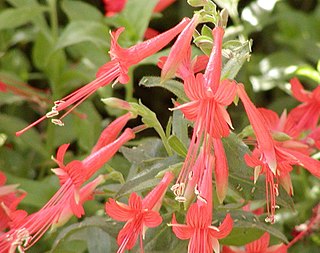
Epilobium canum, also known as California fuchsia or Zauschneria, is a species of willowherb in the evening primrose family (Onagraceae). It is native to dry slopes and in chaparral of western North America, especially California. It is a perennial plant, notable for the profusion of bright scarlet flowers in late summer and autumn.

Casuarina is a genus of flowering plants in the family Casuarinaceae, and is native to Australia, the Indian subcontinent, Southeast Asia, islands of the western Pacific Ocean, and eastern Africa. Plants in the genus Casuarina are monoecious or dioecious trees with green, pendulous, photosynthetic branchlets, the leaves reduced to small scales arranged in whorls around the branchlets, the male and female flowers arranged in separate spikes, the fruit a cone containing grey or yellowish-brown winged seeds.

Juniperus occidentalis, known as the western juniper, is a shrub or tree native to the Western United States, growing in mountains at altitudes of 800–3,000 meters (2,600–9,800 ft) and rarely down to 100 m (330 ft). It is listed as Least Concern on the IUCN Red List because it is a widespread species with an increasing population.

Cecidomyiidae is a family of flies known as gall midges or gall gnats. As the name implies, the larvae of most gall midges feed within plant tissue, creating abnormal plant growths called galls. Cecidomyiidae are very fragile small insects usually only 2–3 mm (0.079–0.118 in) in length; many are less than 1 mm (0.039 in) long. They are characterised by hairy wings, unusual in the order Diptera, and have long antennae. Some Cecidomyiids are also known for the strange phenomenon of paedogenesis in which the larval stage reproduces without maturing first. In some species, the daughter larvae consume the mother, while in others, reproduction occurs later on in the egg or pupa.
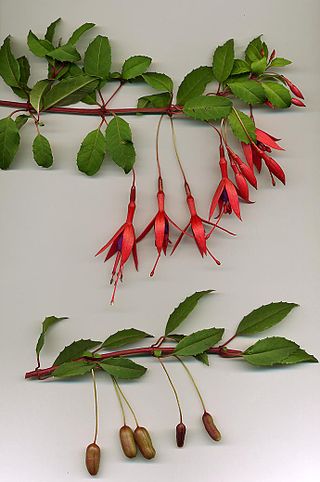
Fuchsia magellanica – commonly known as the hummingbird fuchsia, hardy fuchsia or chilco – is a species of flowering plant in the evening primrose family Onagraceae, native to the lower Southern Cone of southern South America.

Diplotaxis tenuifolia is a species of flowering plant in the mustard family known by the common name perennial wall-rocket. It is native to Europe and western Asia, where it grows on disturbed ground and roadsides, and it can now be found throughout much of the temperate world where it has naturalized. In recent years it has increasingly been cultivated to produce salad leaves, which are marketed as wild rocket in Britain or arugula in the US. It is easily confused with garden rocket, which has similar uses.

Artemisia arbuscula is a North American species of sagebrush known by the common names little sagebrush, low sagebrush, or black sagebrush. It is native to the western United States from Washington, Oregon, and California east as far as Colorado and Wyoming. It grows in open, exposed habitat on dry, sterile soils high in rock and clay content.

Contarinia quinquenotata is a small midge which infests the flower buds of Hemerocallis, causing the buds to swell, remain closed and rot. It is a pest in several parts of the world. It is known by the common names of daylily gall midge and hemerocallis gall midge.

Contarinia nasturtii, the swede midge, is a small fly, the larvae of which infest brassica plants, causing twisting and distortion of the leaf stems and foliage including death of the growing point in seedlings, or damage to developing flower heads. It is native to Europe and Turkey, and has been introduced into North America where it is regarded as an invasive species.

Contarinia is a genus of midges, small flies in the family Cecidomyiidae. There are over 300 described species in the genus.
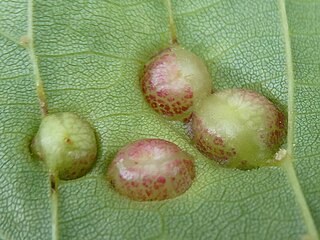
Contarinia verrucicola, known generally as the linden wart gall midge, is a species of gall midges in the family Cecidomyiidae.

Contarinia negundinis, known generally as boxelder gall midge, is a species of gall midges in the family Cecidomyiidae. Other common names include the boxelder bud gall midge and boxelder leaf gall midge. It is the only North American species that enters diapause during the pupal stage of development.
Contarinia virginianiae, known as chokecherry midge or chokecherry gall midge, is a species of gall midges in the family Cecidomyiidae. Its host is the chokecherry Prunus virginiana.
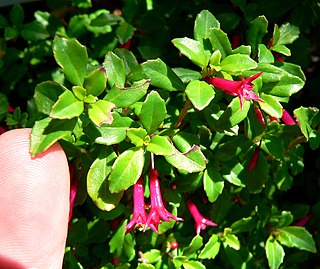
Fuchsia microphylla, also known as small leaf fuchsia and small-leaved fuchsia, is a flowering shrub in the family Onagraceae. The specific epithet (microphylla) was named for the plant's small (micro) leaves (phylla).
Stenodiplosis sorghicola, the sorghum midge, is a species of gall midge in the family Cecidomyiidae. It is a pest of millets. The species is native to Africa and is also found in India. During the rainy season, it feeds on the developing grains of pearl millet plants.
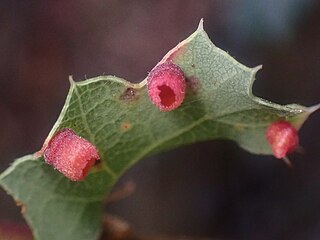
Phylloteras cupella, formerly Trigonaspis cupella, also known as the urn gall wasp or the banded urn gall wasp, is a species of cynipid wasp that induces leaf galls on a number of oak species in western North America. Host species include Arizona white, blue, Engelmann, gray, leather, netleaf, scrub, and shrub oaks. In the United States, galls induced by this species of wasp have been documented in California, Arizona, and New Mexico. This wasp is most likely also in Mexico and Canada.

Asphondylia photiniae, also known as the toyon fruit gall midge or toyon berry gall midge, is a species of midge that induces galls on the developing berries of the toyon bush in North America. Galled berries stay green and look somewhat warped. Each galled berry contains a single larva, which emerges in spring. This midge is known from the Californias, where native Heteromeles arbutifolia grows in relative abundance.

















